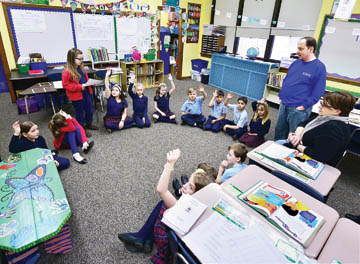
ELGIN—One way that the mission of faith formation is being accomplished with success in Catholic schools in the Rockford Diocese is through the “Catholic Household Program.” Both St. Mary School in Elgin and Holy Cross School in Batavia are using the program.
St. Mary instituted the program in 2013, one year after Barbara Colandrea arrived as principal.
“I heard about this model program which was designed and developed at the Franciscan University of Steubenville in Ohio,” she said. “We then looked at this program, already underway at Holy Cross, and saw how it was making a difference with their student culture. We adapted the program to fit the needs of our elementary and middle school students.”
What is the program all about? When it began at St. Mary, each class from pre-school through eighth grade created a classroom community called a “household.”
Each household creates a mission statement and banner and chooses a class song and a name, such as God’s Angels, for example. These components and symbols will follow them all the way through eighth-grade graduation.
Each class banner is unique and contains the children’s hand prints, names or artwork. As a reminder of their faith and commitment to each other, the banners are always taken to and displayed at Mass.
“Now that we have begun “Catholic households” throughout all of the grades in our school,” said Colandrea, “each subsequent year incoming pre-school students begin the program and start anew.”
“When we first started the program I really thought the eighth graders weren’t going to buy into it but did they surprise me and prove me wrong,” she said.
A highlight of the program takes place every Friday when students take part in a Lord’s Day celebration during their religion class period of the day. The students read and reflect on the upcoming Sunday Gospel, pray together and sing. During prayers, students can focus on Mary and classes can incorporate the rosary.
“Each class is different in how they conduct their time,” Colandrea says. “They sit quietly in a circle and sometimes even shut the lights off ... .
“During Advent, readings can be geared toward the coming of Jesus. Discussions, reflections and prayers can focus on preparing the way for Jesus to our hearts.
“During Lent the students can delve into the meaning of making a sacrifice and how this act helps mirror what Christ did for us.”
When sitting together the students may pass an item the class has chosen around to each other. It may be a cross, a votive candle or a rosary.
The first time around they say their concerns and worries and what they are praying for. The second time around they celebrate what they are grateful for.
“These moments of reflection and their comments are very personal,” Colandrea said. “Since we started this, we have noticed that the students’ behavior has changed, although we never really had any unruly students.
When a child hears another’s problems they have become more compassionate towards one another and grown closer. They find out that everyone has their own worries and they are not alone.”
At first the students mentioned gratitude for their toys and pets, she said. “By the third week, they are more grateful for things,” she said. “One of the students was grateful his father came home safe from a business trip.”
Through the household program, students have learned the importance of taking time out for Jesus outside of church. By reflecting on the Gospel, they are comfortable asking questions about what they don’t understand. By praying with classmates, they are building God-centered relationships.
As students grow in age they can further develop their household. As their faith deepens and their spiritual needs change, they will work together to expand upon their mission statements, change their class songs and deepen their reflection on the Gospel.
In looking back at the program’s beginnings and where it stands today, Colandrea sees how it is has become deeply personal and prepares the students to become active cooperative members in their parishes.
The program provides a space in students’ lives to witness the Holy Spirit at work by flowing through their thoughts, words and hearts.
“I am very hopeful,” she said. “They are the future of the Catholic Church.”














